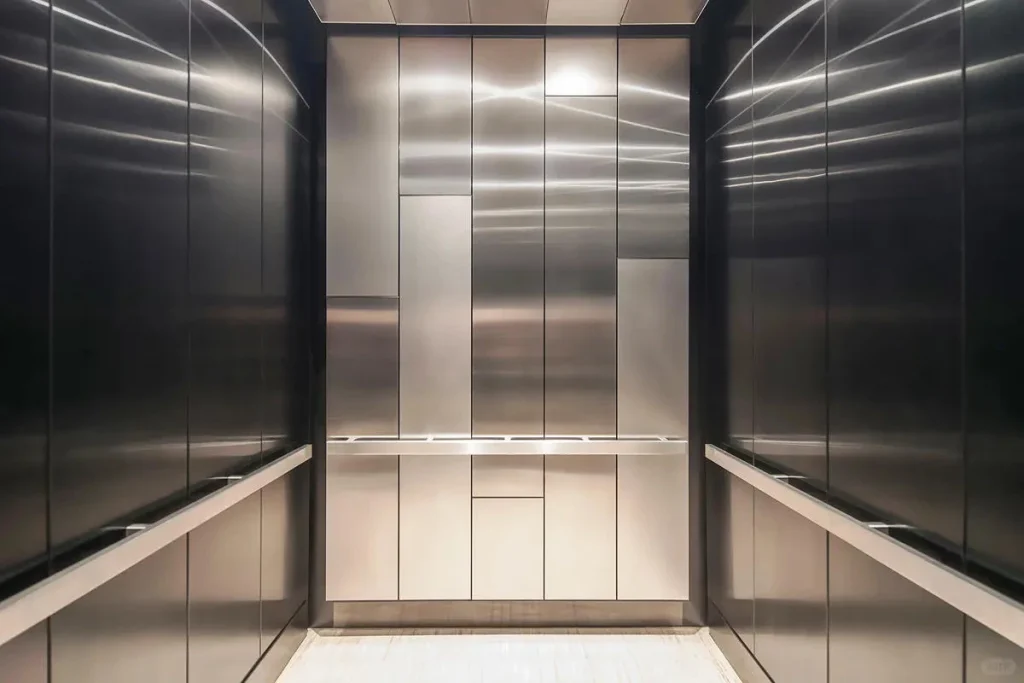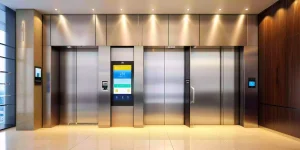Apart from the comfort and finish of an elevator, there is another critical element that shapes your choice—the size. Getting the right passenger lift dimensions is one of the key factors that ensures smooth traffic flow and passenger safety.
When planning for a new passenger elevator, navigating the available passenger lift dimensions is essential to find the best fit for your building and its daily demands.
When planning elevator dimensions, the shaft space you leave and the transport needs are also critical points. This blog will explain the most common passenger lift dimensions and the shaft space required for each, so you can select the most suitable elevator for your building.
For example, an 8-person (544 kg) lift is common in apartments, many hotels use 10–13 person elevators, and large public buildings usually need bigger 18–21 person models.
Standard Passenger Elevator Dimensions
Most elevator brands offer the following five passenger lift dimensions.
8 Passenger lift(544 kg) Dimensions
Car size: 1100 × 1300 mm
Recommended shaft size: MR 1750 × 1700 mm / MRL 1800 × 1800 mm
8 Passenger Elevator is a common choice for small apartments or light-use buildings. It gives reliable daily service while keeping the shaft size compact. It gives reliable daily service while keeping the shaft size compact.
10 Person Elevator (680 kg) Dimensions
Car size: 1300 × 1350 mm
Recommended shaft size: MR 1750 × 1950 mm / MRL 2000 × 1900 mm
This size is popular in hotels and office buildings. It offers enough space for guests with luggage or groups of employees, without requiring a very large shaft.
13 Passenger Lift(884 kg) Dimensions
Car size: 1500 × 1470 mm
Recommended shaft size: MR 2175–2325 × 1900 mm / MRL 2300 × 1900 mm
This model is widely used in commercial and mixed-use projects. It provides enough space for larger groups and is also suited for hospitals and shopping centers where smooth passenger flow is critical.
16 Passenger Lift (1088 kg) Dimensions
Car size: 1700 × 1530 mm
Recommended shaft size: MR 2350–2500 × 2000 mm / MRL ~2500 × 2000 mm (typical)
This larger model is often chosen for hospitals, schools, and public facilities. The added depth allows for stretchers, wheelchairs, or service carts, making it versatile for institutional use.
20 Passenger Elevator (1360 kg) Dimensions
Car size: 1900 × 1580 mm
Recommended shaft size: MR 2550–2700 × 2050 mm / MRL ~2600 × 2300 mm (typical)
This is the largest standard passenger elevator size. It is suitable for airports, convention centers, and tall office towers. With its wide cabin, it can carry many passengers or heavy loads at once.
Passenger Elevator Sizes & Shaft Dimensions Chart
All dimensions in millimeters (mm)
| Rated Persons | Load (kg) | Car Size (W×D) | Hoistway Dimensions (C×D) | Entrance Width | Pit Depth | Machine Room (MA×MB) |
|---|---|---|---|---|---|---|
| 6 | 408 | 1100 × 1000 | 1600 × 1600 | 700 | 1600–2500 | 2400 × 3300 |
| 8 | 544 | 1100 × 1300 | 1750 × 1700 | 800 | 1600–2500 | 2500 × 3500 |
| 10 | 680 | 1300 × 1350 | 1750 × 1950 | 800 | 1600–2500 | 2500 × 3500 |
| 13 | 884 | 1500 × 1470 | 2175–2325 × 1900 | 900 | 1600–2500 | 3000 × 3600 |
| 16 | 1088 | 1700 × 1530 | 2350–2500 × 2000 | 1000 | 1600–2500 | 3000 × 3600 |
| 20 | 1360 | 1900 × 1580 | 2550–2700 × 2050 | 1000 | 1600–2500 | 3000 × 4000 |
Factors That Influence Passenger Elevator Dimensions
Who’s Using the Elevator
This is one of the most important factors when deciding the right passenger elevator dimensions. For apartments or small homes, 8–10 person lifts usually fit best. Hotels and offices often need 10–13 person models to handle busy times and larger groups. Hospitals and public buildings require even bigger 13–21 person elevators, with wide doors that allow stretchers and wheelchairs to pass through safely.
Space Available
Keep in mind that your building does not only include the elevator shaft. You need to leave room for walls, decoration, and safe clearances. MR elevators require a machine room above the shaft, which makes service easier but takes more building space. MRL elevators save space by putting the machine inside the shaft, but this design needs careful planning to ensure enough clearance.
Location & Logistics
Consider the location of the elevator and how it will be installed. If your building has narrow corridors or small entrances, bringing in large components can be difficult. In such cases, machine-room-less (MRL) elevators with modular parts are easier to install, though they still have size limits and require the shaft to meet minimum width and depth.
Budget
Budget is another important factor that shapes elevator dimensions. MR systems are often simpler to service but need more construction space. MRL systems save shaft space and can lower energy use, but their tighter service access may lead to higher maintenance costs later.
For Accessible Elevators
Accessible elevators are designed for people with mobility needs. They usually require features such as wider doors, deeper cabins, smooth floor leveling, and simple controls.
- Wider doors make it easier for wheelchairs and walkers to enter.
- Deeper cabins give more turning space for passengers with mobility aids.
- Safety features like grab rails and voice announcements improve comfort.
Accessible elevators are best in hospitals, clinics, care homes, and any public place that must provide barrier-free travel.
However, they may take more shaft space than standard lifts, and extra features can increase cost.
For Commercial Elevators
Commercial buildings such as offices, malls, and hotels need elevators that can work all day with high passenger flow. They must be reliable, spacious, and built for long hours of service.
- 10–21 person models are common for commercial use.
- Wide doors help groups of people, shoppers, or guests with luggage enter easily.
- Group control systems improve traffic flow during peak hours.
- Attractive interiors or glass cars can add value and improve the user experience.
The drawback is that commercial elevators face heavy use, so they require durable design, regular maintenance, and higher investment at the start.
Related Size Guides
FAQ
My shaft is smaller than the standard size. Can I still install a 10-person elevator?
If the difference is small, yes. Our engineers can review your shaft drawing and suggest solutions such as reducing car depth, selecting a single-slide door to save width, or moving the counterweight to the side. If the shaft is far smaller, a custom 8-person solution may be safer.
What is the difference between MR and MRL?
An MR (machine-room) elevator needs a separate room above or beside the shaft to hold the motor and controller, making maintenance simple. An MRL (machine-room-less) elevator puts the machinery inside the shaft itself, saving building space. MRL is common in modern apartments and malls, while MR is still favored in high-rise or heavy-duty use because service access is easier.
Which size is most common for hotels?
Hotels usually select 10–13 person elevators (800–1000 kg). This size balances guest comfort and handling peak traffic at check-in and breakfast times. For luxury hotels or resorts with luggage carts, a 13-person car with a wider door is often preferred.
Are the shaft sizes in the chart net or gross?
They are net shaft sizes—the clear inside space after finishing. You must also allow for wall thickness, decoration, guide rails, and tolerance. Always confirm with final construction drawings before ordering.
Can I customize car size or door width?
Yes. BDFUJI regularly customizes elevators for hospitals needing stretcher access, shopping malls with heavy cart use, or old buildings with narrow shafts. Options include changing door width, adjusting cabin proportions, and relocating the counterweight to fit your shaft while keeping safety standards.
Conclusion
Just as the design and safety features of an elevator affect the passenger experience, the right passenger lift dimensions are equally important.
To move people comfortably and safely, you need enough cabin space and the right shaft size for your building. Balancing your needs, available shaft space, and budget is the key to getting the most value from your elevator investment.










